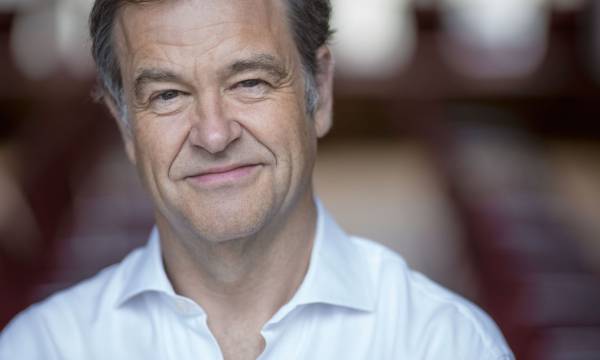
Mahler Festival: Mahler's song cycle Des Knaben Wunderhorn accompanied by Julius Drake (English)
Recital Hall 10 mei 2025 13.00 uur
Beth Taylor mezzo-soprano
Jusung Gabriel Park baritone
Julius Drake piano
Lyrics are available for free in the hall.
Also interesting:
- Did Mahler base his songs on his life?
Gustav Mahler (1860-1911)
Fünf Humoresken from ‘Des Knaben Wunderhorn’ (1892)
Der Schildwache Nachtlied
Das himmlische Leben
Trost im Unglück
Wer hat dies Liedlein erdacht
Verlorne Müh
Lieder, Humoresken und Balladen uit ‘Des Knaben Wunderhorn’ (1893-1901)
Der Tambourg’sell
Wo die schönen Trompeten blasen
Es sungen drei Engel
Lied eines Verfolgten im Turm
Lob des hohen Verstands
Rheinlegendchen
Des Antonius von Padua Fischpredigt
Das irdische Leben
Revelge
Urlicht
no interval
end ± 2.00PM
Beth Taylor mezzo-soprano
Jusung Gabriel Park baritone
Julius Drake piano
Lyrics are available for free in the hall.
Also interesting:
- Did Mahler base his songs on his life?
Gustav Mahler (1860-1911)
Fünf Humoresken from ‘Des Knaben Wunderhorn’ (1892)
Der Schildwache Nachtlied
Das himmlische Leben
Trost im Unglück
Wer hat dies Liedlein erdacht
Verlorne Müh
Lieder, Humoresken und Balladen uit ‘Des Knaben Wunderhorn’ (1893-1901)
Der Tambourg’sell
Wo die schönen Trompeten blasen
Es sungen drei Engel
Lied eines Verfolgten im Turm
Lob des hohen Verstands
Rheinlegendchen
Des Antonius von Padua Fischpredigt
Das irdische Leben
Revelge
Urlicht
no interval
end ± 2.00PM
Toelichting
Gustav Mahler (1860-1911)
Songs from ‘Des Knaben Wunderhorn’
In Gustav Mahler’s oeuvre, song and symphony are intimately linked. This connection is especially evident in the period between 1880-1900, known as the ‘Wunderhorn years,’ when Mahler composed not only his first four symphonies but the Lieder eines fahrenden Gesellen and songs based on texts from the Des Knaben Wunderhorn (‘The Boy’s Magic Horn’) anthology. Mahler’s symphonic works from this time are suffused with the same folkloric quality as his songs, either in the form of a distant echo or a direct quote. In a few cases, Mahler transferred his songs in their entirety to a symphony (Urlicht, Des Antonius von Padua Fischpredigt, Es sungen Drei Engel).
Mahler’s selection of texts from Des Knaben Wunderhorn also reveals something about his youthful memories. He grew up in what was then the Moravian garrison city of Iglau (now Jihlava). There Mahler became familiar with soldiers playing their music while marching past the barracks. However, the ‘military’ texts found in Des Knaben Wunderhorn are far from triumphant. Revelge (‘Reveille’: ‘Ich muss marschieren’) is one poignant example; it deals with a fatally injured drummer boy. In Der Tamboursg’sell (‘The Drummer Boy’) a comrade-in-arms receives a death sentence for desertion. Sometimes, Mahler skilfully unites declarations of love with martial music, as in Wo die schönen Trompeten blasen, but these poems have a decidedly pacifistic tone.
Each of the songs in this cycle has its own orchestra, as it were, in which different instruments come to the fore, lending each song an ever-changing colour palette. Later, Mahler would expand his use of martial rhythms and trumpet calls, and along the way, the Ländler (Rheinlegendchen), a dance of the ‘common folk’, would gradually lose its innocence. Almost everything that makes Mahler a Mahler can already be found here.
Translation: Josh Dillon
In Gustav Mahler’s oeuvre, song and symphony are intimately linked. This connection is especially evident in the period between 1880-1900, known as the ‘Wunderhorn years,’ when Mahler composed not only his first four symphonies but the Lieder eines fahrenden Gesellen and songs based on texts from the Des Knaben Wunderhorn (‘The Boy’s Magic Horn’) anthology. Mahler’s symphonic works from this time are suffused with the same folkloric quality as his songs, either in the form of a distant echo or a direct quote. In a few cases, Mahler transferred his songs in their entirety to a symphony (Urlicht, Des Antonius von Padua Fischpredigt, Es sungen Drei Engel).
Mahler’s selection of texts from Des Knaben Wunderhorn also reveals something about his youthful memories. He grew up in what was then the Moravian garrison city of Iglau (now Jihlava). There Mahler became familiar with soldiers playing their music while marching past the barracks. However, the ‘military’ texts found in Des Knaben Wunderhorn are far from triumphant. Revelge (‘Reveille’: ‘Ich muss marschieren’) is one poignant example; it deals with a fatally injured drummer boy. In Der Tamboursg’sell (‘The Drummer Boy’) a comrade-in-arms receives a death sentence for desertion. Sometimes, Mahler skilfully unites declarations of love with martial music, as in Wo die schönen Trompeten blasen, but these poems have a decidedly pacifistic tone.
Each of the songs in this cycle has its own orchestra, as it were, in which different instruments come to the fore, lending each song an ever-changing colour palette. Later, Mahler would expand his use of martial rhythms and trumpet calls, and along the way, the Ländler (Rheinlegendchen), a dance of the ‘common folk’, would gradually lose its innocence. Almost everything that makes Mahler a Mahler can already be found here.
Translation: Josh Dillon
Gustav Mahler (1860-1911)
Songs from ‘Des Knaben Wunderhorn’
In Gustav Mahler’s oeuvre, song and symphony are intimately linked. This connection is especially evident in the period between 1880-1900, known as the ‘Wunderhorn years,’ when Mahler composed not only his first four symphonies but the Lieder eines fahrenden Gesellen and songs based on texts from the Des Knaben Wunderhorn (‘The Boy’s Magic Horn’) anthology. Mahler’s symphonic works from this time are suffused with the same folkloric quality as his songs, either in the form of a distant echo or a direct quote. In a few cases, Mahler transferred his songs in their entirety to a symphony (Urlicht, Des Antonius von Padua Fischpredigt, Es sungen Drei Engel).
Mahler’s selection of texts from Des Knaben Wunderhorn also reveals something about his youthful memories. He grew up in what was then the Moravian garrison city of Iglau (now Jihlava). There Mahler became familiar with soldiers playing their music while marching past the barracks. However, the ‘military’ texts found in Des Knaben Wunderhorn are far from triumphant. Revelge (‘Reveille’: ‘Ich muss marschieren’) is one poignant example; it deals with a fatally injured drummer boy. In Der Tamboursg’sell (‘The Drummer Boy’) a comrade-in-arms receives a death sentence for desertion. Sometimes, Mahler skilfully unites declarations of love with martial music, as in Wo die schönen Trompeten blasen, but these poems have a decidedly pacifistic tone.
Each of the songs in this cycle has its own orchestra, as it were, in which different instruments come to the fore, lending each song an ever-changing colour palette. Later, Mahler would expand his use of martial rhythms and trumpet calls, and along the way, the Ländler (Rheinlegendchen), a dance of the ‘common folk’, would gradually lose its innocence. Almost everything that makes Mahler a Mahler can already be found here.
Translation: Josh Dillon
In Gustav Mahler’s oeuvre, song and symphony are intimately linked. This connection is especially evident in the period between 1880-1900, known as the ‘Wunderhorn years,’ when Mahler composed not only his first four symphonies but the Lieder eines fahrenden Gesellen and songs based on texts from the Des Knaben Wunderhorn (‘The Boy’s Magic Horn’) anthology. Mahler’s symphonic works from this time are suffused with the same folkloric quality as his songs, either in the form of a distant echo or a direct quote. In a few cases, Mahler transferred his songs in their entirety to a symphony (Urlicht, Des Antonius von Padua Fischpredigt, Es sungen Drei Engel).
Mahler’s selection of texts from Des Knaben Wunderhorn also reveals something about his youthful memories. He grew up in what was then the Moravian garrison city of Iglau (now Jihlava). There Mahler became familiar with soldiers playing their music while marching past the barracks. However, the ‘military’ texts found in Des Knaben Wunderhorn are far from triumphant. Revelge (‘Reveille’: ‘Ich muss marschieren’) is one poignant example; it deals with a fatally injured drummer boy. In Der Tamboursg’sell (‘The Drummer Boy’) a comrade-in-arms receives a death sentence for desertion. Sometimes, Mahler skilfully unites declarations of love with martial music, as in Wo die schönen Trompeten blasen, but these poems have a decidedly pacifistic tone.
Each of the songs in this cycle has its own orchestra, as it were, in which different instruments come to the fore, lending each song an ever-changing colour palette. Later, Mahler would expand his use of martial rhythms and trumpet calls, and along the way, the Ländler (Rheinlegendchen), a dance of the ‘common folk’, would gradually lose its innocence. Almost everything that makes Mahler a Mahler can already be found here.
Translation: Josh Dillon
Biografie
Beth Taylor, mezzo-soprano
Beth Taylor made her debut this season with the Opéra de Nancy singing the title role in La Cenerentola (Rossini). She has also sung Mahler’s Third Symphony with the Royal Stockholm Philharmonic Orchestra and Das Lied von der Erde with the Orchestre de Chambre Paris, and in Alma Mahler’s Fünf Lieder with the Orchestre symphonique de Montréal.
The Scottish mezzo-soprano made her Concertgebouw debut in 2019 in Mendelssohn’s oratorio Christus and Mozart’s Mass in C minor in a concert conducted by Jan Willem de Vriend. Taylor studied at the Royal Conservatoire of Scotland, where her teachers included Jennifer Larmore.
In 2023 she was a finalist in the BBC Cardiff Singer of the World Competition, and in 2019 she won third prize in the Wigmore Hall Competition. She gives recitals with leading pianists such as Julius Drake, Malcolm Martineau and Mathieu Pordoy.
This is her first appearance in the Recital Hall.
Jusung Gabriel Park, baritone
The South Korean baritone Jusung Gabriel Park is a member of the ensemble of the Wiener Staatsoper. The young singer drew international attention when he won third prize in Operalia 2021.
In the same year, he represented his native country during the BBC Cardiff Singer of the World Competition.
Park studied in Seoul at Yonsei University, where he had lessons with Chang-gon Kim, Kwang-dong Kim, Hei-kyung Hong, Florian Boesch and Margit Klaushofer. He also participated in the Académie du Festival d’Aix-en-Provence and the Internationale Meistersinger Akademie, under the guidance of Edith Wiens.
In addition to opera, he is also interested in the concert repertoire and art song, and he performs frequently in Bach’s Johannes-Passion and Weihnachtsoratoriumand in Fauré’s Requiem. He has sung Beethoven’s Ninth Symphony with the Seoul Philharmonic Orchestra conducted by Jaap van Zweden.
He is making his debut in The Concertgebouw.
Julius Drake, piano
Julius Drake enjoys an international reputation as one of today’s best song accompanists. His passion for art song has resulted in invitations from The Concertgebouw, London’s Wigmore Hall and the BBC, among others, to put together song recital series.
He organises an annual recital series in London’s historic Middle Temple Hall, Julius Drake and Friends, where he is joined by outstanding singers including Sir Thomas Allen, Véronique Gens, Simon Keenlyside and Felicity Lott. Drake has made recordings with many artists, including Gerard Finley, Ian Bostridge and Christianne Stotijn.
He received his education at the Purcell School and the Royal College of Music in London. He currently teaches piano/song accompaniment at the Kunstuniversität Graz in Austria. In December 2022 Drake was awarded the Concertgebouw Medal.


